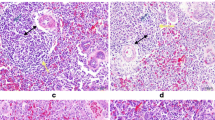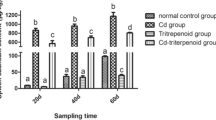Abstract
In order to determine the relationship between boron and development of the spleen, especially in the promoting biological effects, we examined the effects of different levels of boron on weight, organ index, microstructure, and antioxidative activities of the spleen in rats. Sprague-Dawley (SD) rats were selected and treated with different concentrations of boron, and then, the organs were resected and weighed. One half of the tissue was fixed and embedded in paraffin to observe tissue structure changes. The other half of the tissue was homogenated for determining the antioxidant activities. The results showed that 40 mg/L of boron could increase weight, organ indexes, and antioxidant capacity of spleens and improve the spleen tissue structure, while the boron concentration above 80 mg/L could decrease weight, organ indexes, and antioxidant capacity of spleens and damage the spleen tissue structure. The higher the concentration, the more serious the damage was. Especially at the concentration of 640 mg/L, it could significantly inhibit the development of the spleen and even exhibit toxic effect. Hence, low boron concentration played a protective role in the development of the spleen, while high boron concentration could damage the organs and even produce toxic effect.




Similar content being viewed by others
References
Nielsen FH (2002) The nutritional importance and pharmacological potential of boron for higher animals and human. In: Goldbach HE et al (eds) Boron in plant and animal nutrition. Kluwer Academic/Plenum, New York, pp 37–49
Haro Durand LA, Mesones RV, Nielsen FH, Gorustovich AA (2010) Histomorphometric and microchemical characterization of maturing dental enamel in rats fed a boron-deficient diet. Biol Trace Elem Res 135:242–252
Cheng JY, Peng KM, Jin EH, Zhang Y, Liu Y, Zhang NB, Song H, Liu HZ, Tang ZL (2011) Effect of additional boron on tibias of African ostrich chicks. Biol Trace Elem Res 144:538–549
Ying XZ, Cheng SW, Wang W, Lin ZQ, Chen QY, Zhang W, Kou DQ, Shen Y, Cheng XJ, Rompis FA, Peng L, Zhu Lu C (2011) Effect of boron on osteogenic differentiation of human bone marrow stromal cells. Biol Trace Elem Res 144:306–315
Geyikoğlu F, Türkez H (2007) Acute toxicity of boric acid on energy metabolism of the breast muscle in broiler chickens. Biologia, Bratislava 62(1):112–117
Kloppmann W, Bianchini G, Charalambides A, Dotsika E, Guerrot C, Klose P, Marei A, Pennisi M, Vengosh A, Voutsa D (2005) Boron contamination of Mediterranean groundwater resources: extent, sources and pathways elucidated by environmental isotopes. Geophys Res Abstr 7:10162
Armstrong TA, Spears JW (2003) Effects of boron supplementation of pig diets on the production of tumor necrosis factor-α and interferon-γ. J Anim Sci 81(10):2552–2561
Armstrong TA, Spears JW, Lloyd KE (2001) Inflammatory response, growth, and thyroid hormone concentrations are affected by long-term boron supplementation in gilts. J Anim Sci 79(6):1549–1556
Müezzinoğlu T, Korkmaz M, Nese N et al (2011) Prevalence of prostate cancer in high boron-exposed population: a community-based study. Biol Trace Elem Res 144:49–57
O’Sullivan K, Taylor M (1983) Chronic boric acid poisoning in infants. Arch Dis Child 58:737–749
Litovitz TL, Klein-Schwartz W, Oderda GM, Schmitz BF (1988) Clinical manifestations of toxicity in a series of 784 boric acid ingestions. Am J Emerg Med 6:209–213
Devirian TA, Volpe SL (2003) The physiological effects of dietary boron. Crit Rev Food Sci Nutr 43:219–231
Fail PA, Chapin RE, Price CJ, Heindel JJ (1998) General, reproductive, developmental and endocrine toxicity of boronated compounds. Reprod Toxicol 12(1):1–18
Hubbard SA, Sullivan FM (1996) Toxicological effects of inorganic boron compounds in animals: a review of the literature. J Trace Elem Exp Med 9:165–173
Gu YF, Li SH, Wang J, Shang CF, Chen HL (2007) Effects of boron poisoning on thymus development in Gushi chickens. Indian Vet J 84(6):584–586
Hunt CD (1998) One possible role of dietary boron in higher animals and humans. Biol Trace Elem Res 66(1–3):205–225
Hunt CD, Idso JP (1999) Dietary boron as a physiological regulator of the normal inflammatory response: a review and current research progress. J Trace Elem Exp Med 12:221–233
Bai Y, Hunt CD, Newman SM (1997) Dietary boron increases serum antibody (IgG and IgM) concentrations in rats immunized with human typhoid vaccine. Proc North Dakota Acad Sci 51:181
Bai Y, Hunt CD (1995) Dietary boron alleviates adjuvant-induced arthritis (AIA) in rats. FASEB J 9:A576
Ince S, Kucukkurt I, Cigerci IH, Fatih Fidan A, Eryavuz A (2010) The effects of dietary boric acid and borax supplementation on lipid peroxidation, antioxidant activity, and DNA damage in rats. J Trace Elem Med Biol 24(3):161–164
Ince S, Keles H, Erdogan M, Hazman O, Kucukkurt I (2012) Protective effect of boric acid against carbon tetrachloride-induced hepatotoxicity in mice. Drug Chem Toxicol 35(3):285–292
Mebius RE, Kraal G (2005) Structure and function of the spleen. Nat Rev Immunol 5:606–616
Feng BM, Li X, Li SH et al (2009) Effect of drinking boron on blood composition in rats. J Hyg Res 38(4):485–488 (in Chinese)
Kurtoğlu F, Kurtoğlu V, Celik I, Kececi T, Nizamlioğlu M (2005) Effects of dietary boron supplementation on some biochemical parameters, peripheral blood lymphocytes, splenic plasma cells and bone characteristics of broiler chicks given diets with adequate or inadequate cholecalciferol (vitamin D3) content. Br Poult Sci 46(1):87–96
Hunt CD (2003) Dietary boron: an overview of the evidence for its role in immune function. J Trace Elem Exp Med 16:291–306
Li SH, Fan GL, Gu YF, Wang J, Peng KM, Jin GM, Liu DY, Chen HL (2009) Effect of drinking boron supplemented on the development of center immune organs in Gushi chickens. J Northwest A F Univ (Nat Sci Ed) 2(37):52–58 (in Chinese)
Li SH, Gu YF, Fan GL, Wang J, Peng KM, Jin GM, Chen HL, Shang CF (2008) Effect of different level drinking boron supplemented on the development of immune organs in Gushi chickens. Chin Soc Immunol 1(24):47–48 (in Chinese)
Li SH, Zhu HG, Wang J, Jin GM, Gu YF, Liu DY (2009) Effect of environmental estrogen boron on microstructure of thymus in rats. J Anhui Sci Technol Univ 23(6):1–5 (in Chinese)
Wang J, Li SH, Jin GM, Shang CF, Chen HL, Gu YF (2007) Effect of drinking-boron on jejunum development of animal. Stud Trace Elem Health 24(2):1–4 (in Chinese)
Hunt CD, Herbel JL, Idso JP (1994) Dietary boron modifies the effects of vitamin D3 nutrition on indices of energy substrate utilization and mineral metabolism in the chick. J Bone Miner Res 9(2):171–182
Pahl MV, Culver BD, Vaziri ND (2005) Boron and the kidney review. J Ren Nutr 15(4):362–370
Wang K (1996) Trace elements in life sciences, 2nd edn. Chinese Metrology, Beijing, pp 377–402
Wang J, Gu YF, Li SH, Shang CF, Chen HL (2005) Effect of boron on development of jejunum in Gushi chickens. Chin J Vet Sci 25(5):514–517 (in Chinese)
Bakirdere S, Orenay S, Korkmaz M (2010) Effect of boron on human health. Open Miner Process J 3:54–59
Kucukkurt I, Akbel E, Karabag F, Ince S (2013) The effects of dietary boron compounds in supplemented diet on hormonal activity and some biochemical parameters in rats. Toxicol Ind Health. doi:10.1177/0748233712469648
Acknowledgements
This work was supported by Key Projects of Scientific and Technological Research of Education Ministry, China (210095); Natural Science Fund of Anhui, China (090411001, 1308085MC50, and 1208085QC68); Key Discipline Construction Program of Anhui Science and Technology University, China (AKXK20101-2); and Talents Special Foundation of Anhui Science and Technology University, China (ZRC2013353 and ZRC2013354).
Author information
Authors and Affiliations
Corresponding author
Rights and permissions
About this article
Cite this article
Hu, Q., Li, S., Qiao, E. et al. Effects of Boron on Structure and Antioxidative Activities of Spleen in Rats. Biol Trace Elem Res 158, 73–80 (2014). https://doi.org/10.1007/s12011-014-9899-5
Received:
Accepted:
Published:
Issue Date:
DOI: https://doi.org/10.1007/s12011-014-9899-5




